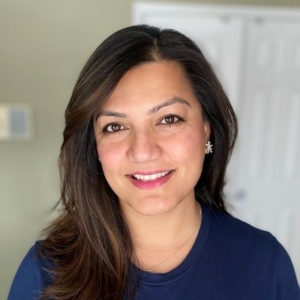An Innovative Approach to Understanding the Needs of Our Patients
Objectives
At the end of this series of podcasts, the participant should be able to:
- Describe an innovative approach to understanding the needs of our patients
- Understand how multiple functions in a pharmaceutical company can collaborate and work towards a common mission for patients.

INTERVIEWER: Prachi Parmar


INTERVIEWEE: Michelle Quinlan, PharmD


INTERVIEWEE: Sraddha Wadhwa

Following is an automated transcription provided by otter.ai. Please excuse inaccuracies.
Prachi Parmar 0:01
Hi everyone, welcome to the medical affairs professional societies medical information, three part Podcast Series around medical information and listening to and understanding the needs of our patients. In the first podcast we spoke about patient centricity within medical information and approaches to improve patient engagement and experiences. In this second podcast, we will discuss an innovative approach to listening to and understanding the needs of our patients. I am Prachi Parmar, and today I’ll be the moderator for this podcast. I’m currently supporting products within the hospital business unit and Pfizer medical information. The views expressed in this recording are those of the individuals and do not necessarily reflect on the opinions of maps or the companies with which they are affiliated. This presentation is for informational purposes only and is not intended as legal or regulatory advice. We encourage you to engage in conversations about patient centricity with other maps members via maps connect on the maps website or mobile app. Simply login with the email address and password associated with your maps account and access the maps global community. Then click on the discuss tab and scroll down to patient centricity to post a question or review previous postings. Today’s podcasts objectives are to one to describe an innovative approach to understanding the needs of our patients. And to understand how multiple functions in a pharmaceutical company can collaborate and work towards a common mission for patients. I’d like to thank today’s panelists for sharing their subject matter expertise with the maps membership. Joining me today for our second podcast of the series are my friends and colleagues. Michelle Quinlan, Associate Director, medical information Pfizer and shraddha Wadhwa, Director of medical information Pfizer. So, as you may recall from the last podcasts, Michelle Robin, I have been working together for over 10 years and have done a lot of great work in the patient space. And today we are here to talk to you about an innovative approach we took to further understand our patient’s needs. This podcast is a better experience. When we can talk we conducted the patient insight forum. And before we begin, I will let them introduce themselves. Michelle?
Michelle Quinlan 2:34
Thanks, Prachi. My name is Michelle Quinlan and I’m an Associate Director of medical information at Pfizer. I currently support the internal medicine and rare disease portfolio products. Thank you. Hi, everyone.
Sraddha Wadhwa 2:46
My name is shraddha Wadhwa, I serve as a compliance focus area director at Pfizer. I’ve been with Pfizer for over 10 years and currently serve on the internal medicine, rare disease team.
Prachi Parmar 2:57
Great, thank you both for being here. So I have been reflecting on how much Pfizer global medical information has evolved over the past several years. With regard to patient focus. It’s been so encouraging to see how far we have come and how we are continuing to develop and patient engagement. Do you remember a couple of years ago when we embarked on the patient insight form journey?
Michelle Quinlan 3:25
Wow, yes, Prachi. That was such an innovative and impactful experiment. We certainly learned quite a bit from that experience.
Sraddha Wadhwa 3:32
I definitely agree. It was really a great time and experiment. But guys, remind me again, how did it all begin before my particular product was involved?
Prachi Parmar 3:42
Yeah, great question. So it actually began in Brazil, where the team there initiated a patient insight forum for another product. The intent of that whole initiative was to listen to our patients and really understand their needs and challenges, and then attempt to meet those needs and finally offer up a great experience for patients. In Brazil, the product that was chosen to focus on was due to a high patient inquiry volume. There were specific needs and challenges that were identified for patients being treated with this particular product. The Pfizer MIT team there adopted a dare to try framework for their patient insight forum. So as a quick refresher, the dare dare to try is a concept that promotes innovation, design, thinking and agile experimentation. It’s it helps us to brainstorm more effectively think differently and solve big challenges.
Michelle Quinlan 4:42
If you both may recall, our patient Insights Team plan to take the similar approach and apply globally to other products across different regions. Our first step here in the US was to intimately review patient insight reports for the top six consumer High Line products. We put a lot of thought into it. An effort into this first step, because we knew that in order for us to have such a successful forum, we really needed to hone down and choose the right product.
Prachi Parmar 5:09
Yes, I remember that. We’ve reviewed multiple product insight reports. But we also needed to consider other factors as well. For example, are there clear patient needs and challenges that were identified? Could we recruit the necessary stakeholders to partner with us on this project? Where is the product and its lifecycle and how strong is the relationship with medical information? After careful thought and consideration the product that Shada was currently supporting at the time was the winner.
Sraddha Wadhwa 5:41
It’s always great to be a winner. I was so excited when you both approached me about this idea. I was sold from the beginning and definitely motive motivated to make an impact in the typical patient’s life. That takes my product, I remember that one of the first things we needed to do was understand the issues that our patients are facing. And then in addition to analyzing medical information insights, we also sought insights from other groups advisor, such as medical marketing, and product quality, to name a few. We were looking for some high level themes among the various insights, we also needed to ensure that we had full participation from our stakeholders. And we’d be in the process of recruitment by meeting with one to two colleagues separately, to underscore the importance of this forum, and how it is in alignment with the broader Pfizer mission.
Prachi Parmar 6:26
It was so exciting to meet with each of these stakeholders, as we explained your vision for the patient insight forum. You know, I remember that every single one of them showed enthusiasm and support for our patients as they committed to being an active participant of this forum.
Michelle Quinlan 6:43
Yes, and you know, on for me, it was so amazing that we were able to include so many diverse functions that all supported this particular product. For example, we included medical, commercial product quality, enterprise benefit risk field, medical directors, market analytics colleagues, and also colleagues from regulatory and legal. Additionally, what’s so amazing is that if you recall, we were able to recruit a former patient to be a part of this forum to further help us view the issues from that patient lens.
Prachi Parmar 7:13
And you know, another fun thing about this forum was that in parallel to recruiting the relevant stakeholders, we also needed to recruit our dare to try facilitators. And these were the people that would really lead the brainstorming and ideation session that day of the forum, we were lucky to get two great facilitators that added tremendous value to our session, they truly promoted the dare to try framework and capsule set session participants stimulated to openly share their ideas in this non judgmental setting.
Sraddha Wadhwa 7:48
I remember how hard we all were, though before the session to prepare all the pre work and identify the common themes that represented the top challenges that a patient taking this particular product may be dealing with, you know, we created the detailed insight packet, and also identified the breakout sessions and respective participants. To ensure there was diversity in each group, we were lucky to have several medical information leaders participating in the session on the day of the forum. Remember, we also had virtual colleagues participate, we accommodated for those who couldn’t attend live in headquarters, which was fantastic because we achieved 100% attendance.
Michelle Quinlan 8:26
Yes, and I also just want to note that we did that several pre work items through compliance so that we ensure that we were sharing information appropriately, with Pfizer internal stakeholders.
Prachi Parmar 8:36
Looking back, I have such wonderful memories of that day. And I remember the excitement and the high energy everyone had in the room, it was so impressive to see all the stakeholders come together with the same purpose and common goal in mind. The three of us opens with different parts of the presentation, before we hand it over to our dear to try facilitators. And what was really nice was that we were all able to actively participate in one of the breakout sessions.
Sraddha Wadhwa 9:08
And because this was my product at the time, it was really great to see all the touch points aligned for one common goal to meet the needs of our patients. I developed relationships which remain after the forum, which helped in collaboration with different innovative projects for our patients.
Michelle Quinlan 9:24
Also, you know, what really stood out for me was that one interesting item coming out of these sessions was that when we began digging in and analyzing all of these insights from different functional areas, we were able to identify some overlap and common themes, we were able to further reinforce our ideas for opportunities to create additional patient content within medical information that could be more effective in addressing patient needs. All in all,
Prachi Parmar 9:49
what a successful day. This patient insight forum represented the initiation of important discussions around the therapeutic area in action. In particular, the Pfizer product and focus. This was really just the beginning of the conversation. We know that this insight forum had long lasting impact. Here we are several years later. And we have such impressive examples of patient response documents, infographics and other innovative content, discussing key patient topics that are currently being used in a minute. So I would like to thank our speakers today, Michelle, and traba. This has been the second podcast in a series on the topic of patient engagement. In the third and last session of this podcast, we will get to discuss in more detail the specific Pfizer medical information patient initiatives that we were able to implement. If you are a maps member, thank you for your support of maps. If you are not yet a maps member, and would like to access additional resources in this area. Please visit the maps website to explore joining today at medical affairs.org forward slash membership. This concludes today’s podcast



